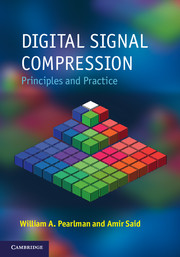Book contents
- Frontmatter
- Contents
- Preface
- Acknowledgments
- 1 Motivation
- 2 Book overview
- 3 Principles of lossless compression
- 4 Entropy coding techniques
- 5 Lossy compression of scalar sources
- 6 Coding of sources with memory
- 7 Mathematical transformations
- 8 Rate control in transform coding systems
- 9 Transform coding systems
- 10 Set partition coding
- 11 Subband/wavelet coding systems
- 12 Methods for lossless compression of images
- 13 Color and multi-component image and video coding
- 14 Distributed source coding
- Index
- References
3 - Principles of lossless compression
Published online by Cambridge University Press: 05 June 2012
- Frontmatter
- Contents
- Preface
- Acknowledgments
- 1 Motivation
- 2 Book overview
- 3 Principles of lossless compression
- 4 Entropy coding techniques
- 5 Lossy compression of scalar sources
- 6 Coding of sources with memory
- 7 Mathematical transformations
- 8 Rate control in transform coding systems
- 9 Transform coding systems
- 10 Set partition coding
- 11 Subband/wavelet coding systems
- 12 Methods for lossless compression of images
- 13 Color and multi-component image and video coding
- 14 Distributed source coding
- Index
- References
Summary
Introduction
Source coding began with the initial development of information theory by Shannon in 1948 [1] and continues to this day to be influenced and stimulated by advances in this theory. Information theory sets the framework and the language, motivates the methods of coding, provides the means to analyze the methods, and establishes the ultimate bounds in performance for all methods. No study of image coding is complete without a basic knowledge and understanding of the underlying concepts in information theory.
In this chapter, we shall present several methods of lossless coding of data sources, beginning with the motivating principles and bounds on performance based on information theory. This chapter is not meant to be a primer on information theory, so theorems and propositions will be presented without proof. The reader is referred to one of the many excellent textbooks on information theory, such as Gallager [2] and Cover and Thomas [3], for a deeper treatment with proofs. The purpose here is to set the foundation and present lossless coding methods and assess their performance with respect to the theoretical optimum when possible. Hopefully, the reader will derive from this chapter both a knowledge of coding methods and an appreciation and understanding of the underlying information heory.
The notation in this chapter will indicate a scalar source on a one-dimensional field, i.e., the source values are scalars and their locations are on a one-dimensional grid, such as a regular time or space sequence.
Information
- Type
- Chapter
- Information
- Digital Signal CompressionPrinciples and Practice, pp. 23 - 40Publisher: Cambridge University PressPrint publication year: 2011
